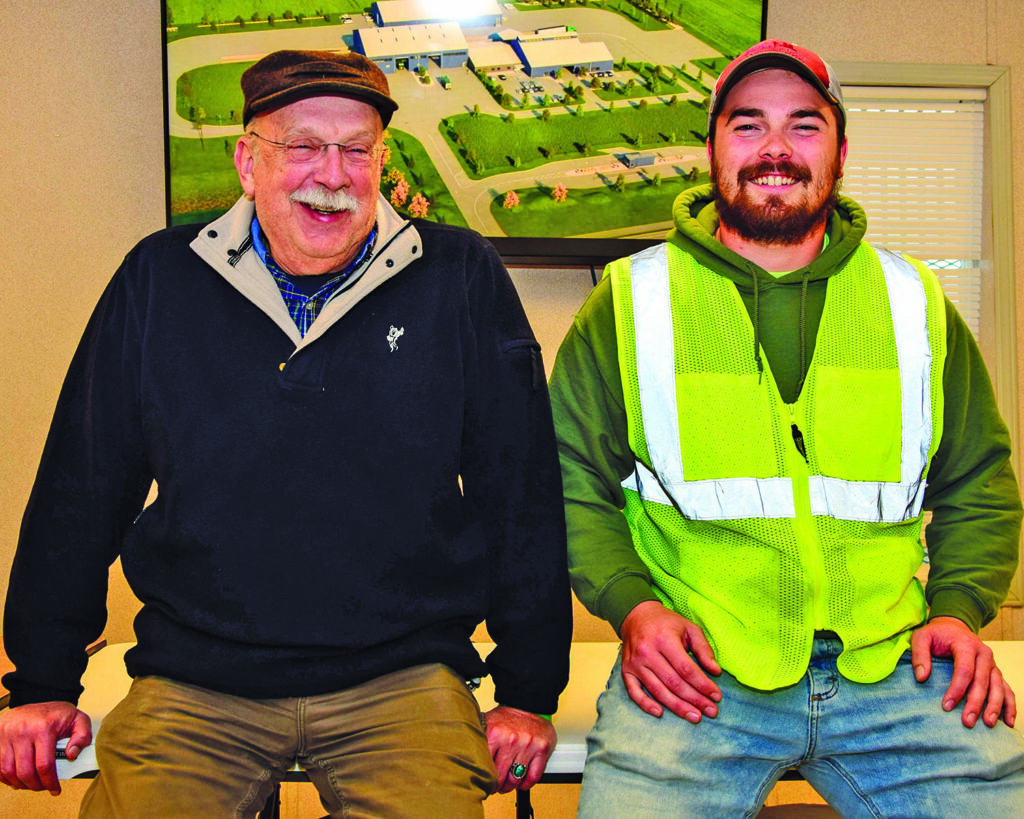
Clay County Solid Waste director Kirk Rosenberger and Aric Berg of Project Engineers, Inc.
Nancy Edmonds Hanson
Clay County’s garbage will be cleaner and leaner next year as the long-awaited Resource Recovery Center goes into operation.
“When people take their trash to the curb, they don’t have to think about it anymore,” county solid waste manager Kirk Rosenberger says. But it’s only the beginning of a great deal of thought determining what happens next – a huge responsibility that has only loomed larger as the city and county’s population grows.
The new Resource Recovery Center has long been viewed as a key to coping with the growing mountains of garbage generated every year – nearly 40,000 tons of it. Located at the corner of 34th Street and 15th Avenue North, the $17.4 million solid waste facility will provide a single point where garbage from Moorhead and other Clay County towns, as well as individual households, can be gathered, sorted and loaded for transport to its eventual destinations – the Prairie Lakes Resource Facility incinerator in Perham and the county’s 182-acre landfill site southwest of Hawley. Another $4.4 million will be invested in transport equipment and a shredder to shrink the volume of furniture and mattresses.
The resource center, slated for completion at this time next year, will consolidate waste facilities currently all over town – the Moorhead Transfer Station on Highway 10, the drop site for household waste also on Highway 10, and the drop-off for electronic garbage on 15th Avenue North.
“This was the first project I began work on when I took this job seven years ago,” says county solid waste manager Kirk Rosenberger. That’s when the state Pollution Control Agency granted $600,000 for final design work on the long-envisioned collaboration between the city of Moorhead and Clay County. But when local leaders went to the Minnesota Legislature for funding to help build the center, their request was turned aside.
Finally, in 2020, legislators included $7.5 million in the state bonding bill so construction could begin. Though less than the $8.5 million request, the city and county partners were able to get the building project underway. In the meantime, however, the original price tag of $12.5 million in 2015 had risen by almost half. The balance of funding will now come from county reserves, fees and long-term bonding.
“We can’t thank our local delegation enough for their work in finally getting this passed,” Rosenberger says. Sen. Kent Eken and Reps. Paul Marquardt and Ben Lien are three of the best legislators I’ve ever worked with.”
Extensive site preparation and utility work is nearly complete on the 20 acres of farmland across from the wind turbines on 34th Street. That includes the 200-foot-long, 20-foot-deep tunnel that will run beneath the largest section of the building, the tipping floor where garbage trucks will disgorge their loads. Problem trash will be sorted there, removing mattresses, furniture, propane tanks, tires and the like. Then the rest of what’s been collected in Moorhead and other towns will be pushed to the center of the floor, to be dropped onto semi-trailers in the tunnel underneath for trucking to the Perham incinerator and county landfill.
The tipping floor, equal in size to three football fields, is just one of three functions to be contained in the 40,000 sq. ft. prefabricated building – now manufactured to engineers’ specifications and soon to be transported to the site. The center section will house the solid waste department’s offices and staff of four.
At the other end is another key destination, where problem materials will be collected in a 20,000 sq. ft. center for separate handling and disposal.
One side of that section is dedicated to hazardous household waste – paint, stains, pesticides, herbicides and solvents and other dangerous chemicals that can’t go in the regular garbage. Next door, electronics will be collected to be shipped to specialized recycling destinations that can recover some elements of their manufacture like lead in monitor and TV screens, precious metals in electronics and mercury that’s contained in fluorescent bulbs. Included are televisions, all kinds of computer gear, non rechargeable batteries and appliances.
Clay residents will be able to drop off their problem garbage five days a week at no charge. “The commission wants to keep this stuff out of ditches,” Rosenberger explains, adding that area farmers sometimes come in with pickup loads of these kinds of refuse that they’ve gathered out of rural ditches.
Incoming and outgoing trucks will be weighed in a separate building to establish tonnage. According to Rosenberger, the tipping fee of $50 per ton helps support the center’s operations, along with other service fees and modest assessments on county property taxes. Single-family homes currently pay $42 per year; that will rise to $45 in 2022.


